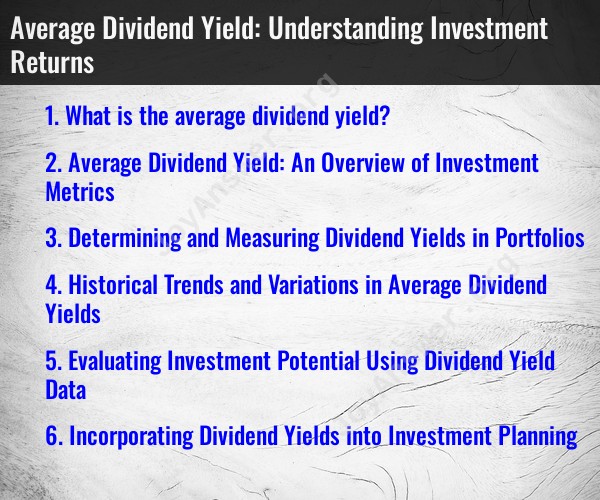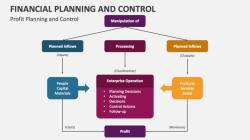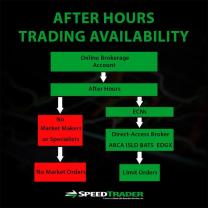What is the average dividend yield?
The average dividend yield refers to the average percentage of income generated from dividends relative to the investment's market price. It is a measure used in finance and investing to assess the income potential of an investment, particularly in dividend-paying stocks or funds. The formula for calculating dividend yield is as follows:
Average Dividend Yield = (Annual Dividend Payment / Market Price) x 100
Annual Dividend Payment: This represents the total annual dividends paid by the investment. It can be determined by summing the individual dividend payments made over a year.
Market Price: This is the current market price or market value of the investment. It's the price at which the investment is trading on the stock market.
The average dividend yield is expressed as a percentage. It tells investors how much income they can expect to receive annually as a percentage of the current market price of the investment. A higher dividend yield indicates a potentially higher income stream relative to the investment's price, while a lower yield suggests a lower income stream.
The average dividend yield can vary significantly among different types of investments. For example:
Stocks: Individual stocks can have varying dividend yields. Some stocks pay high dividends, while others may not pay any dividends at all.
Mutual Funds: Dividend yield for mutual funds depends on the mix of assets held within the fund. Dividend-focused mutual funds may have higher yields.
Exchange-Traded Funds (ETFs): Like mutual funds, ETFs have dividend yields based on their portfolio composition. ETFs designed to track dividend-focused indices will have higher yields.
Bonds: Bonds pay interest, not dividends, so their yield is expressed as the coupon rate. However, some investors may refer to the interest income as a type of "bond dividend."
Real Estate Investment Trusts (REITs): REITs are known for their high dividend yields, as they are required to distribute a significant portion of their income to shareholders.
It's important to note that the average dividend yield is just one aspect to consider when evaluating an investment. Investors should also assess the stability of the dividend payments, the financial health of the company or investment, and their own investment objectives and risk tolerance. High dividend yields may come with higher risks, so a balanced approach to investing is often recommended. Additionally, the average dividend yield for the entire stock market or a specific sector can change over time due to economic conditions and market dynamics.
Average Dividend Yield: An Overview of Investment Metrics
The average dividend yield is a financial metric that measures the average dividend payout of a portfolio of stocks. It is calculated by dividing the total dividends paid by the total market value of the portfolio.
The average dividend yield is an important metric for income investors, as it provides a measure of the current income potential of their portfolio. It is also a useful metric for comparing different investment portfolios.
Determining and Measuring Dividend Yields in Portfolios
To determine the average dividend yield of a portfolio, you can use the following formula:
Average dividend yield = Total dividends paid / Total market value of portfolio
For example, if a portfolio pays $10,000 in dividends annually and has a total market value of $100,000, then the average dividend yield is 10%.
You can also measure the average dividend yield of a specific stock or index by using the following formula:
Dividend yield = Dividend per share / Price per share
For example, if a stock pays a dividend of $1 per share and has a price per share of $50, then the dividend yield is 2%.
Historical Trends and Variations in Average Dividend Yields
The average dividend yield of the S&P 500 index has historically ranged from 1% to 6%. The average dividend yield is currently around 2%.
There are a number of factors that can affect the average dividend yield, including:
- Economic conditions: The average dividend yield tends to be higher during economic downturns and lower during economic expansions. This is because companies are more likely to reduce or eliminate their dividends during downturns in order to conserve cash.
- Interest rates: The average dividend yield tends to move inversely with interest rates. When interest rates are rising, investors can earn a higher return on their money from other investments, such as bonds and CDs. This can make stocks with lower dividend yields less attractive.
- Company policies: Some companies have policies of paying out a certain percentage of their earnings in dividends. Other companies may choose to retain more of their earnings to invest in growth.
Evaluating Investment Potential Using Dividend Yield Data
The average dividend yield can be used to evaluate the investment potential of a stock or portfolio in a number of ways:
- Comparing different investments: The average dividend yield can be used to compare the income potential of different stocks or portfolios. For example, if two stocks have similar prices but different dividend yields, the stock with the higher dividend yield will provide a higher income return.
- Identifying undervalued stocks: Stocks with dividend yields that are above the average may be undervalued. This is because the market may not be fully appreciating the income potential of these stocks.
- Building a high-income portfolio: Investors can build a high-income portfolio by selecting stocks with attractive dividend yields. This can be a good way to generate income for retirement or other financial goals.
Incorporating Dividend Yields into Investment Planning
When incorporating dividend yields into investment planning, it is important to consider the following factors:
- Investment goals: Investors should consider their investment goals and risk tolerance when selecting stocks with dividend yields. For example, investors who are nearing retirement may want to focus on stocks with high dividend yields and low volatility.
- Tax considerations: Dividend income is taxed as ordinary income. Investors should factor this into their investment planning.
- Reinvestment: Investors can reinvest their dividends to purchase more shares of stock. This can help to grow their portfolio over time.
Conclusion
The average dividend yield is an important metric for income investors. It can be used to compare different investments, identify undervalued stocks, and build a high-income portfolio. When incorporating dividend yields into investment planning, it is important to consider investment goals, tax considerations, and reinvestment.












